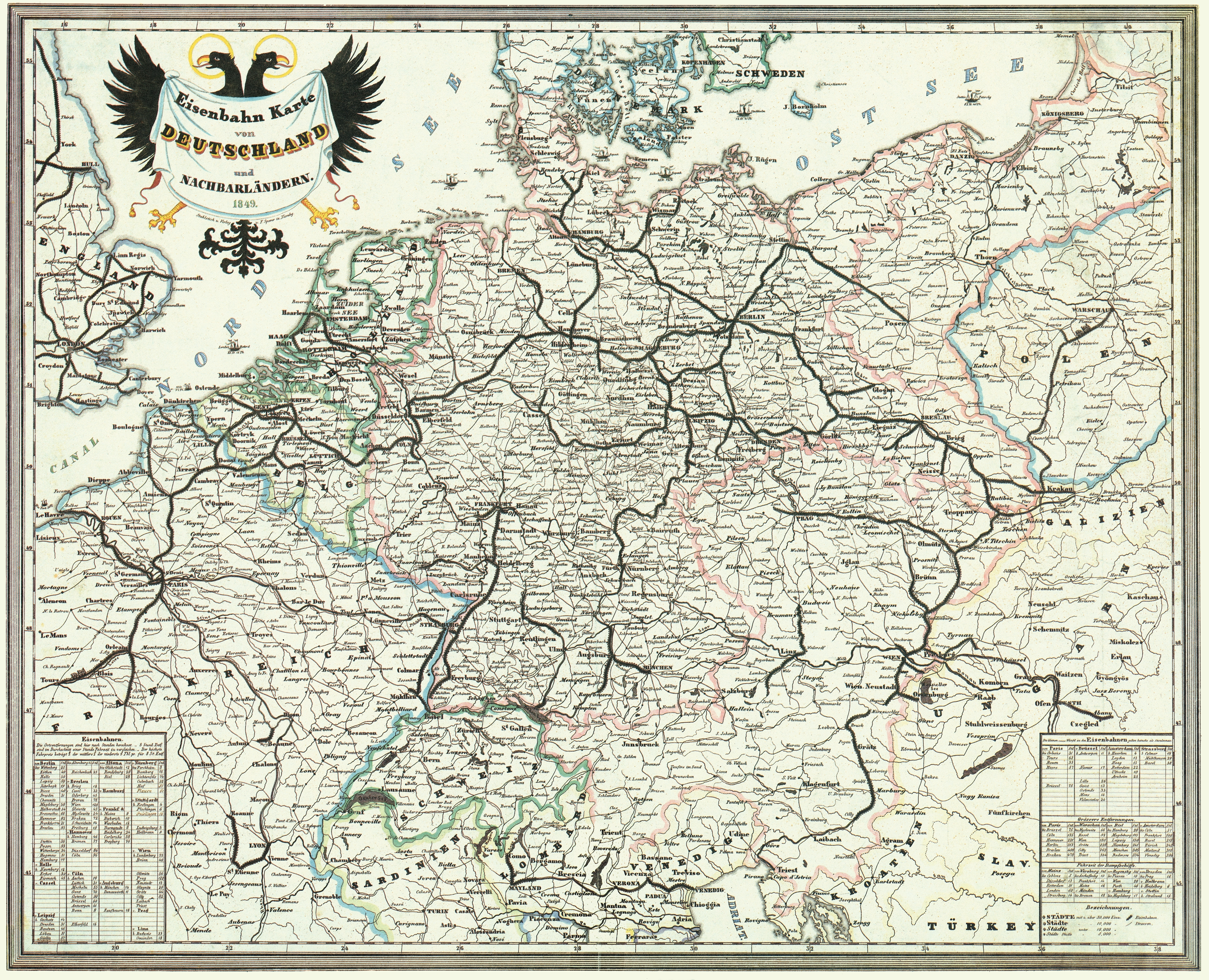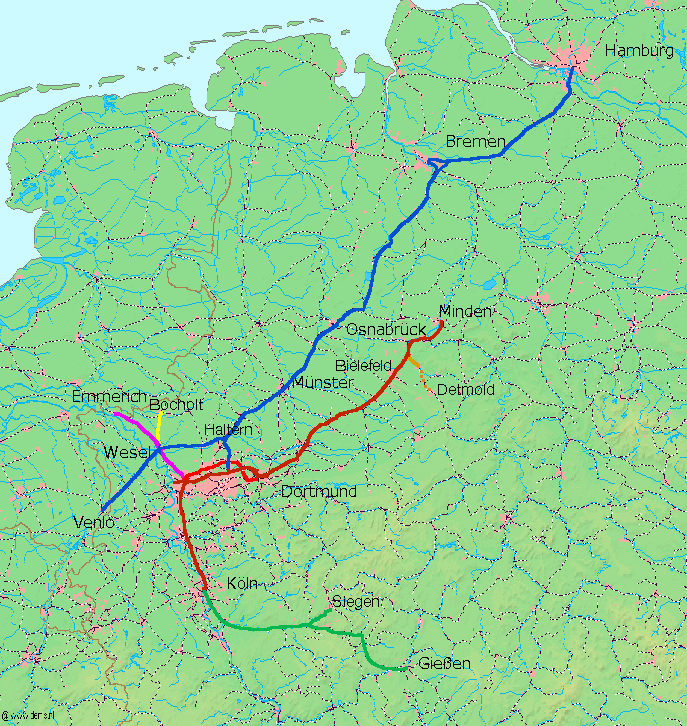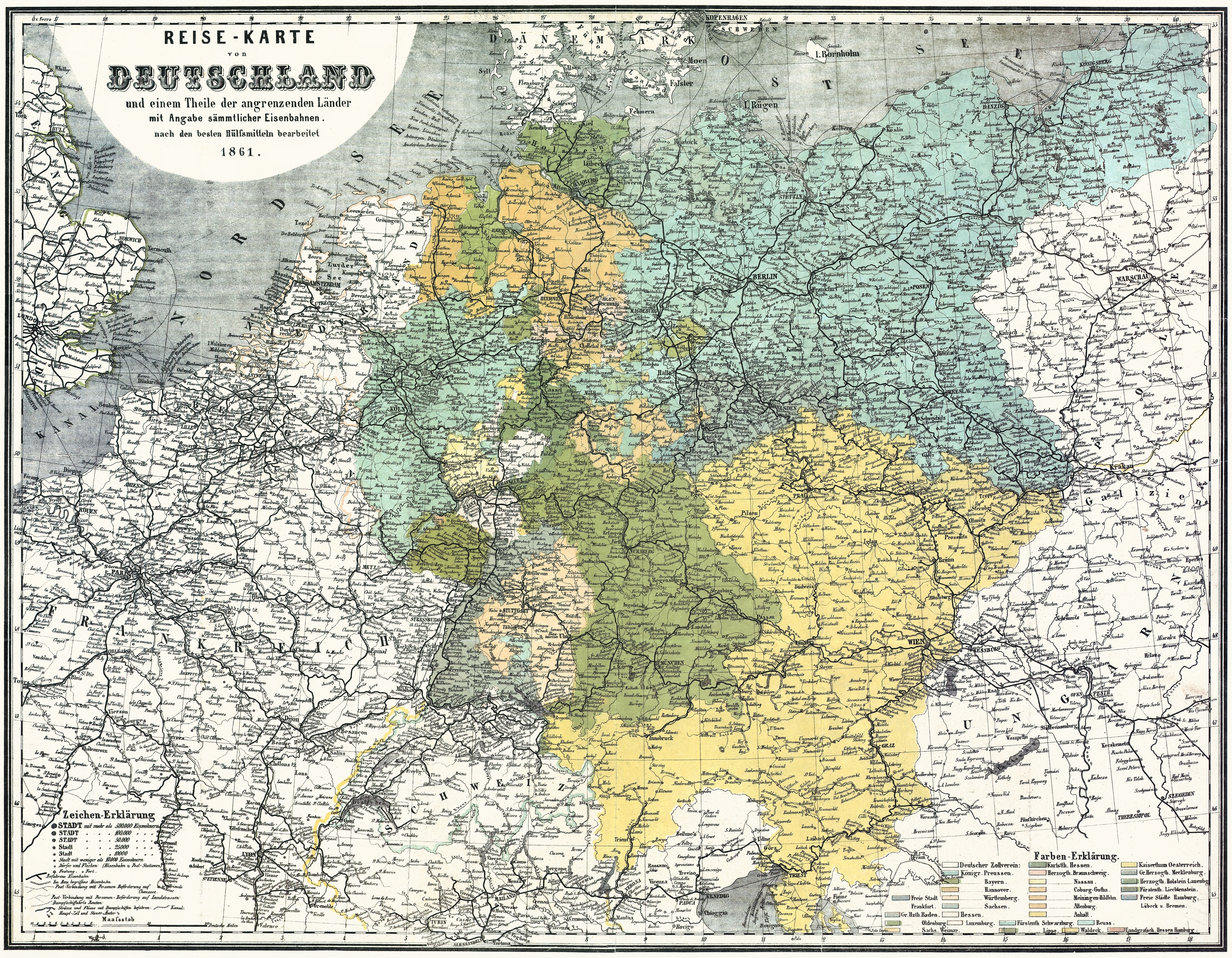|
Münster–Hamm Railway
The Münster–Hamm railway is an almost 36 kilometre-long, continuous double-track and electrified main line railway from Münster to Hamm in the German state of North Rhine-Westphalia. It was one of Germany's oldest railways, built by the ''Munster Hamm Railway Company'', which was established for this purpose, and opened on 26 May 1848. History The Cologne-Minden Railway Company (, CME) built its trunk line directly across Westphalia, bypassing the region around the town of Münster. The ''Munster Hamm Railway Company'' (''Münster-Hammer Eisenbahn-Gesellschaft'', MHE) was established to build a branch line to connect with the CME line. This line was opened on 26 May 1848 for passengers and on 8 July 1848 for freight traffic. The company and line were taken over in 1855 by the Prussian government-funded Royal Westphalian Railway Company (KWE). The line was extended in the following year to Rheine as the Münster–Rheine line. Operations Although, formerly individualNot ... [...More Info...] [...Related Items...] OR: [Wikipedia] [Google] [Baidu] |
15 KV AC Railway Electrification
Railway electrification using at are used on transport railways in Rail transport in Germany, Germany, Rail transport in Austria, Austria, Rail transport in Switzerland, Switzerland, Rail transport in Sweden, Sweden, and Rail transport in Norway, Norway. The high voltage enables high power transmission with the lower frequency reducing the losses of the traction motors that were available at the beginning of the 20th century. Globally, railway electrification in late 20th century tends to use 25 kV AC railway electrification, AC systems which has become the preferred standard for new railway electrifications. Nevertheless, local extensions of the existing network is commonplace. In particular, the Gotthard Base Tunnel (opened on 1 June 2016) uses 15 kV, 16.7 Hz electrification. Due to high conversion costs, it is unlikely that existing systems will be converted to despite the fact that this would reduce the weight of the on-board step-down transformers to one t ... [...More Info...] [...Related Items...] OR: [Wikipedia] [Google] [Baidu] |
Lippe (river)
The Lippe () is a river in North Rhine-Westphalia, Germany. It is a right tributary of the Rhine and in length with an elevation difference of 125 metres and a catchment area of 4.890 km². The source is located at the edge of the Teutoburg Forest in Bad Lippspringe close to the city of Paderborn. It runs westward through Paderborn, Lippstadt and then along the northern edge of the Ruhr area, parallel to the river Emscher and river Ruhr (river), Ruhr. The river finally enters the Rhine at Wesel. Description and history The river Lippe has been used as an infrastructure in Roman times. For the Romans the river (named ''Lupia'') was a gateway to Germania, running from the river Rhine to the region around Paderborn. The watercourse was used for transport of supplies, so along the banks of the Lippe many former Roman camps could be found. In the last 200 years many of these camps have been identified, above all the camp in Haltern which is likely to be the former headquarter of ... [...More Info...] [...Related Items...] OR: [Wikipedia] [Google] [Baidu] |
Prussia
Prussia (; ; Old Prussian: ''Prūsija'') was a Germans, German state centred on the North European Plain that originated from the 1525 secularization of the Prussia (region), Prussian part of the State of the Teutonic Order. For centuries, the House of Hohenzollern ruled Prussia, expanding its size with the Prussian Army. Prussia, with its capital at Königsberg and then, when it became the Kingdom of Prussia in 1701, History of Berlin, Berlin, decisively shaped the history of Germany. Prussia formed the German Empire when it united the German states in 1871. It was ''de facto'' dissolved by 1932 Prussian coup d'état, an emergency decree transferring powers of the Prussian government to German Chancellor Franz von Papen in 1932 and ''de jure'' by Abolition of Prussia, an Allied decree in 1947. The name ''Prussia'' derives from the Old Prussians who were conquered by the Teutonic Knightsan organized Catholic medieval Military order (religious society), military order of Pru ... [...More Info...] [...Related Items...] OR: [Wikipedia] [Google] [Baidu] |
Westphalia
Westphalia (; ; ) is a region of northwestern Germany and one of the three historic parts of the state of North Rhine-Westphalia. It has an area of and 7.9 million inhabitants. The territory of the region is almost identical with the historic Province of Westphalia, which was a part of the Kingdom of Prussia from 1815 to 1918 and the Free State of Prussia from 1918 to 1946. In 1946, Westphalia merged with North Rhine, another former part of Prussia, to form the newly created state of North Rhine-Westphalia. In 1947, the state with its two historic parts was joined by a third one: Lippe, a former Principality of Lippe, principality and Free State of Lippe, free state. The seventeen Districts of Germany, districts and nine Independent city#Germany, independent cities of Westphalia and Lippe (district), the single district of Lippe are members of the North Rhine-Westphalia#Subdivisions, Westphalia-Lippe Regional Association (''Landschaftsverband Westfalen-Lippe''). Previo ... [...More Info...] [...Related Items...] OR: [Wikipedia] [Google] [Baidu] |
Cologne-Minden Trunk Line
{{unreferenced, date=January 2014 The Cologne-Minden trunk line is a railway built by the Cologne-Minden Railway Company (''Cöln-Mindener Eisenbahn-Gesellschaft'', CME). The line is the westernmost part of the railway line from Berlin to the Rhine that was proposed by Friedrich List in his Concept for a railway network in Germany, published in 1833. In fact, Friedrich Harkort (“father of the Ruhr”) had proposed the construction of a railway line from Cologne to Minden in 1825. History On 18 December 1843, the CME was awarded the concession to build a railway line between the metropolis of Cologne, the cities of the Rhenish-Westphalian industrial area and Minden to connect with the network of the Royal Hanoverian State Railways. A route through the Bergisches Land had been dropped was due to the high cost of the engineering structures that would have been required on the advice of the Aachen merchant and banker David Hansemann (1790-1864), who was then briefly Prussian ... [...More Info...] [...Related Items...] OR: [Wikipedia] [Google] [Baidu] |
Cologne-Minden Railway Company
The Cologne-Minden Railway Company (German, old spelling: ''Cöln-Mindener Eisenbahn-Gesellschaft'', ''CME'') was along with the Bergisch-Märkische Railway Company and the Rhenish Railway Company one of the railway companies that in the mid-19th century built the first railways in the Ruhr and large parts of today's North Rhine-Westphalia. Founding The founding of the Cologne-Minden Railway Company in 1843 in Cologne ended a long struggle for a railway line between the Rhineland and the German North Sea ports, as well as the Prussian capital of Berlin. From the 1830s several railway committees in the cities of Düsseldorf, Cologne and Aachen attempted to find a solution with each other and the Prussian government. The focus of all these efforts was to avoid the Dutch duties on trade on the Rhine, which significantly increased the cost of import and export of goods via the Rhine. Some of the Cologne committee members under David Hansemann (1790–1864)—a merchant and banker fro ... [...More Info...] [...Related Items...] OR: [Wikipedia] [Google] [Baidu] |
List Of The First German Railways To 1870
List of the first German railways to 1870 with German railways ordered by date of the commissioning the first phase of construction. For context see History of rail transport in Germany. Maps References * * {{DEFAULTSORT:Germany railways History of rail transport in Germany Lists of firsts ... [...More Info...] [...Related Items...] OR: [Wikipedia] [Google] [Baidu] |
German State
The Federal Republic of Germany is a federation and consists of sixteen partly sovereign ''states''. Of the sixteen states, thirteen are so-called area-states ('Flächenländer'); in these, below the level of the state government, there is a division into local authorities (counties and county-level cities) that have their own administration. Two states, Berlin and Hamburg, are city-states, in which there is no separation between state government and local administration. The state of Bremen is a special case: the state consists of the cities of Bremen, for which the state government also serves as the municipal administration, and Bremerhaven, which has its own local administration separate from the state government. It is therefore a mixture of a city-state and an area-state. Three states, Bavaria, Saxony, and Thuringia, use the appellation ("free state"); this title is merely stylistic and carries no legal or political significance (similar to the US states that call them ... [...More Info...] [...Related Items...] OR: [Wikipedia] [Google] [Baidu] |
Münster
Münster (; ) is an independent city#Germany, independent city (''Kreisfreie Stadt'') in North Rhine-Westphalia, Germany. It is in the northern part of the state and is considered to be the cultural centre of the Westphalia region. It is also a Münster (region), state district capital. Münster was the location of the Münster Rebellion, Anabaptist rebellion during the Protestant Reformation and the site of the signing of the Treaty of Westphalia ending the Thirty Years' War in 1648. Today, it is known as the bicycle capital of Germany. Münster gained the status of a ''Großstadt'' (major city) with more than 100,000 inhabitants in 1915. , there are 300,000 people living in the city, with about 61,500 students, only some of whom are recorded in the official population statistics as having their primary residence in Münster. Münster is a part of the international EUREGIO, Euregio region with more than 1,000,000 inhabitants (Enschede, Hengelo, Gronau, North Rhine-Westphalia, G ... [...More Info...] [...Related Items...] OR: [Wikipedia] [Google] [Baidu] |
Dortmund–Hamm Railway
The Dortmund–Hamm Railway is an important and historically significant railway in Germany. It is a major axis for long distance passenger and freight trains between the Ruhr and the north and east of Germany. It is the part of the trunk line built by the Cologne-Minden Railway Company (German, old spelling: ''Cöln-Mindener Eisenbahn-Gesellschaft'', ''CME'') from Köln Deutz to Minden. It was opened in 1847 and has been modernized and developed several times since then. History On 18 December 1843, the Prussian government granted a concession to the CME for the line, which began at what was then the CME station in Deutz (now a suburb of Cologne) with the construction of the first section to Düsseldorf, which was opened on 20 December 1845. Only a few weeks later, on 9 February 1846, the second section was completed to a temporary terminus at the site of present-day Duisburg Hauptbahnhof called the ''Cologne-Minden railway station'', the first of three train stations bui ... [...More Info...] [...Related Items...] OR: [Wikipedia] [Google] [Baidu] |
Oberhausen-Osterfeld Süd–Hamm Railway
The Oberhausen-Osterfeld Süd–Hamm railway, also called the Hamm-Osterfeld line (), is a 76-kilometre long double-track electrified main line railway at the northern edge of the Ruhr in the German state of North Rhine-Westphalia. It has a continuous level route with no tunnels. Its eastern and central sections are now only used for freight, while its western section is also for passenger operations. The main operator, Deutsche Bahn (formerly Deutsche Bundesbahn), has always referred to this line as the ''Nordstrecke'' ("northern line"). It was the northernmost route of the former railway division of Essen. History The line was built to relieve the existing network of railways in the Ruhr region, which was at the limit of its capacity, especially for freight traffic. The line was opened on 1 May 1905. It served primarily as a direct connection between the two major marshalling yards of Hamm and Osterfeld Süd to allow long-distance freight trains to avoid the Ruhr and to ena ... [...More Info...] [...Related Items...] OR: [Wikipedia] [Google] [Baidu] |
Hagen–Hamm Railway
The Hagen–Hamm railway is a continuous two-track, electrified main line in the German state of North Rhine-Westphalia, connecting Hagen via Schwerte, Holzwickede and Unna to Hamm. History The railway line from Hagen to Hamm was built by the Bergisch-Märkische Railway Company (German: ''Bergisch-Märkische Eisenbahn-Gesellschaft'', BME) to link its existing Elberfeld–Dortmund and Dortmund–Soest lines as well as Hamm station. The section between Holzwickede and Unna was opened by the BME on 9 July 1855 as part of its Dortmund–Soest line. Ten years later, on 18 January 1866, the section from Unna to Hamm was made available for passenger traffic, while the section from Hagen to Holzwickede opened a year later on 1 April 1867. Current situation The whole length of the line is served hourly by Regional-Express services on lines RE 7, the '' Rhein-Münsterland-Express'' (Rheine–Krefeld), and RE 13, the ''Maas-Wupper-Express'' (Hamm–Venlo). The section between Hagen and ... [...More Info...] [...Related Items...] OR: [Wikipedia] [Google] [Baidu] |







